Read and Campbell Limited was a British manufacturer of firefighting equipment founded in 1878. The company was an early pioneer in the design and manufacture of portable fire extinguishers.
Read and Campbell Limited was a British manufacturer of firefighting equipment founded in 1878. The company was an early pioneer in the design and manufacture of portable fire extinguishers.
The company was founded in 1881 by two Scottish engineers, Messrs Read and Campbell, who had been bridge building in Argentina formed a company, Aerators Ltd., to make carbon dioxide and gas cylinders. They formed the company Read and Campbell Ltd. in 1881 and registered a design in Great Britain in the same year to cover "the arrangement for piercing capsules" to expel water, carbon tetrachloride etc. by means of a CO2 cartridge. The patent was granted in 1909. The fire extinguisher worked on the principle of a pressurised CO2 cartridge being pierced, the pressure inside thus released expanding into the extinguisher body and expelling the contents under pressure. Other types of extinguishers worked by mixing sulphuric acid with a solution of bicarbonate and water-the soda acid extinguisher.
With the growth in motoring and the use of petrol engines there was a call for an extinguisher especially designed for fighting petrol fires. In 1911 Read and Campbell took out patent rights in Argentina on their 'Petrolex' extinguisher. This was a carbon tetrachloride extinguisher operated by a CO2 cartridge. The Royal Automobile Club conducted tests on the 'Petrolex' which passed with flying colours. 'Waterloo' extinguishers-water filled, were installed in many Royal residences and public buildings including 'Windsor Castle and all the Royal Palaces of England',the British Museum, the Victoria and Albert Museum and the General Post Office. Royal cars were fitted with 'Petrolex' extinguishers.
The North Metropolitan Electric Power Supply Company carried out a series of stringent tests on the 'Petrolex' extinguisher and informed Read and Campbell that, 'I have never seen any fire extinguishing appliance that seemed as well suited and effective for dealing with fires in Electrical Stations'. Further patents were granted in France and Brazil during this period. In 1914 foam compound was registered in Great Britain. Read and Campbell introduced their 'Rocsuds' which was an early form of foam extinguisher. The contents were, amongst other things, saponin, derived from the roots of soapwort, sodium bicarbonate, extract of vegetable syrup from quillaia and liquorice. There was a great expansion of business during this period because of military requirements during the First World War. At this time the 'Waterloo' copper-bodied extinguisher was introduced-it was claimed that the copper did not discolour the water, and prevented staining of tapestries and oil painting in art galleries and Museums.
The 'Tetra' and 'Roc-Tetra' carbon tetrachloride hand pump for vehicles was introduced in 1927 and adopted by the RAC for use on vehicles in its Road Service fleet.
An article in the 'Evening Chronicle' appeared in 1928 stated that it was a legal necessity for motorists to have their garages equipped with fire extinguishers or to empty their petrol tanks each time they put their cars away.
In 1929 the Duke of York's household was protected by Read and Campbell extinguishers and precise instructions on fire drill procedure were printed. In the same year the Athenaeum Club, the National Gallery and the Victoria and Albert Museum were equipped with Read and Campbell extinguishers.
During the Second World War, Read and Campbell continued to manufacture extinguishers, both for civilian and military use.
In 1948 the company was awarded the contract for supplying extinguishers to London Transport. The Read and Campbell copper shell extinguisher was installed in the Royal Automobile Club in London. This pure copper extinguisher was very popular where appearance was important.
The business was acquired by Chubb and Sons in 1964 but continued to operate from Horsham as Read and Campbell until the formation of Chubb Fire Security Limited in 1971.

Carbon dioxide is a chemical compound with the chemical formula CO2. It is made up of molecules that each have one carbon atom covalently double bonded to two oxygen atoms. It is found in the gas state at room temperature, and as the source of available carbon in the carbon cycle, atmospheric CO2 is the primary carbon source for life on Earth. In the air, carbon dioxide is transparent to visible light but absorbs infrared radiation, acting as a greenhouse gas. Carbon dioxide is soluble in water and is found in groundwater, lakes, ice caps, and seawater. When carbon dioxide dissolves in water, it forms carbonate and mainly bicarbonate, which causes ocean acidification as atmospheric CO2 levels increase.

Sodium bicarbonate (IUPAC name: sodium hydrogencarbonate), commonly known as baking soda or bicarbonate of soda, is a chemical compound with the formula NaHCO3. It is a salt composed of a sodium cation (Na+) and a bicarbonate anion (HCO3−). Sodium bicarbonate is a white solid that is crystalline, but often appears as a fine powder. It has a slightly salty, alkaline taste resembling that of washing soda (sodium carbonate). The natural mineral form is nahcolite. It is a component of the mineral natron and is found dissolved in many mineral springs.

Sodium carbonate is the inorganic compound with the formula Na2CO3 and its various hydrates. All forms are white, odourless, water-soluble salts that yield alkaline solutions in water. Historically, it was extracted from the ashes of plants grown in sodium-rich soils. Because the ashes of these sodium-rich plants were noticeably different from ashes of wood, sodium carbonate became known as "soda ash". It is produced in large quantities from sodium chloride and limestone by the Solvay process, as well as by carbonating sodium hydroxide which is made using the Chlor-alkali process.

Potassium bicarbonate (IUPAC name: potassium hydrogencarbonate, also known as potassium acid carbonate) is the inorganic compound with the chemical formula KHCO3. It is a white solid.

Carbon tetrachloride, also known by many other names (such as carbon tet for short and tetrachloromethane, also recognised by the IUPAC) is a chemical compound with the chemical formula CCl4. It is a non-flammable, colourless liquid with a "sweet" chloroform-like smell that can be detected at low levels. It was formerly widely used in fire extinguishers, as a precursor to refrigerants and as a cleaning agent, but has since been phased out because of environmental and safety concerns. Exposure to high concentrations of carbon tetrachloride can affect the central nervous system and degenerate the liver and kidneys. Prolonged exposure can be fatal.

Smokeless powder, also referred to as gunpowder, is a type of propellant used in firearms and artillery that produces less smoke and less fouling when fired compared to black powder. The combustion products are mainly gaseous, compared to around 55% solid products for black powder. In addition, smokeless powder does not leave the thick, heavy fouling of hygroscopic material associated with black powder that causes rusting of the barrel.
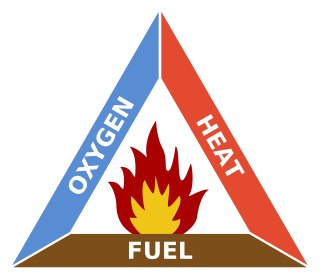
Fire control is the practice of reducing the heat output of a fire, reducing the area over which the fire exists, or suppressing or extinguishing the fire by depriving it of fuel, oxygen, or heat. Fire prevention and control is the prevention, detection, and extinguishment of fires, including such secondary activities as research into the causes of fire, education of the public about fire hazards, and the maintenance and improvement of fire-fighting equipment.
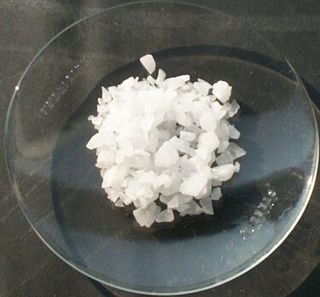
Aluminium sulfate is a salt with the formula Al2(SO4)3. It is soluble in water and is mainly used as a coagulating agent (promoting particle collision by neutralizing charge) in the purification of drinking water and wastewater treatment plants, and also in paper manufacturing.
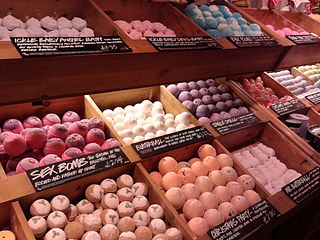
A bath bomb or bath fizzie is a consumer product used during bathing. It was invented and patented in 1989 by Mo Constantine, co-founder of Lush Cosmetics. It is a compacted mixture of wet and dry ingredients molded into any of several shapes and then dried. Bath water effervesces at the surface of a bath bomb immersed within it, with attendant dispersion of such ingredients as essential oil, moisturizer, scent, or colorant.

UTC Climate, Controls & Security was a global provider of building technologies offering fire safety, security, building automation, heating, ventilating, air-conditioning, and refrigeration systems and services. A wholly owned subsidiary of United Technologies Corporation, UTC Climate, Controls & Security was a $16.7 billion company with 55,000 employees serving customers in more than 180 countries.
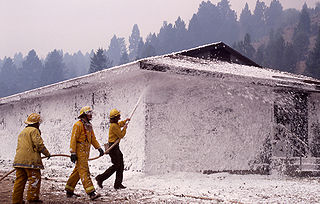
Firefighting foam is a foam used for fire suppression. Its role is to cool the fire and to coat the fuel, preventing its contact with oxygen, thus achieving suppression of the combustion. Firefighting foam was invented by the Russian engineer and chemist Aleksandr Loran in 1902.
Kidde is a brand and division of Carrier Global that manufactures and distributes fire detection and suppression equipment, as well as smoke and CO alarm units. Kidde is one of America's largest manufacturer of smoke alarms and fire safety products. Kidde is headquartered in Mebane, NC.

Chubb Fire & Security is a global organization specialised in fire protection and security systems, and is a subsidiary of APi Group Corporation.
A fire class is a system of categorizing fire with regard to the type of material and fuel for combustion. Class letters are often assigned to the different types of fire, but these differ between territories; there are separate standards for the United States, Europe, and Australia. The fire class is used to determine the types of extinguishing agents that can be used for that category.

A fire extinguisher is a handheld active fire protection device usually filled with a dry or wet chemical used to extinguish or control small fires, often in emergencies. It is not intended for use on an out-of-control fire, such as one which has reached the ceiling, endangers the user, or otherwise requires the equipment, personnel, resources or expertise of a fire brigade. Typically, a fire extinguisher consists of a hand-held cylindrical pressure vessel containing an agent that can be discharged to extinguish a fire. Fire extinguishers manufactured with non-cylindrical pressure vessels also exist but are less common.
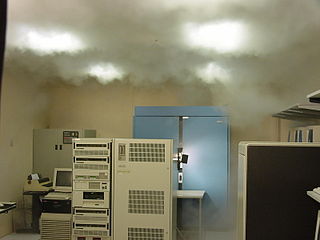
Automatic fire suppression systems control and extinguish fires without human intervention. Examples of automatic systems include fire sprinkler system, gaseous fire suppression, and condensed aerosol fire suppression. When fires are extinguished in the early stages loss of life is minimal since 93% of all fire-related deaths occur once the fire has progressed beyond the early stages.

Minimax Limited was a British manufacturer of fire extinguishers founded in England in 1903. Their unique conical fire extinguisher was known as 'The Minimax'. The company was purchased by The Pyrene Company Limited in 1955.

The Pyrene Company Limited from their beginning in 1914, until 1971 when they became Chubb Fire Security Limited, were among the world's leaders in the manufacture of fire fighting equipment. The name Pyrene was epitomised by their famous 'pump' extinguisher which was installed on public transport, commercial and private vehicles throughout the western world.
The Rampart Engineering Company was a British manufacturer of fire extinguishers founded in 1910.
E-diesel is a synthetic diesel fuel created by Audi for use in automobiles. Currently, e-diesel is created by an Audi research facility in partnership with a company named Sunfire. The fuel is created from carbon dioxide, water, and electricity with a process powered by renewable energy sources to create a liquid energy carrier called blue crude which is then refined to generate e-diesel. E-diesel is considered to be a carbon-neutral fuel as it does not extract new carbon and the energy sources to drive the process are from carbon-neutral sources. As of April 2015, an Audi A8 driven by Federal Minister of Education and Research in Germany is using the e-diesel fuel.